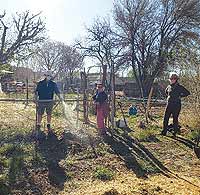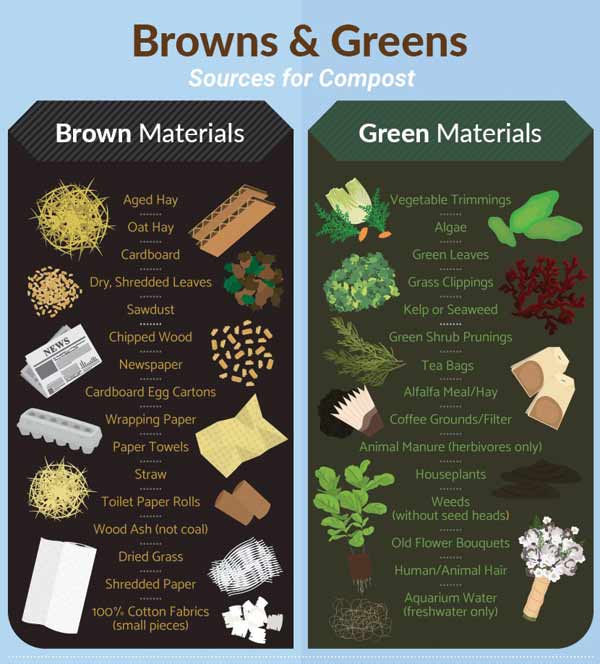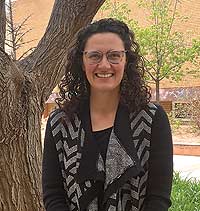 Composting. The word can invoke a flood of questions: How do I do it? What goes in it? Isn’t it a lot of work? Is composting really that effective? Where do I even start? Composting. The word can invoke a flood of questions: How do I do it? What goes in it? Isn’t it a lot of work? Is composting really that effective? Where do I even start?
These were all questions I had when I first considered planting an in-ground garden at my home here in Moab. Especially as an employee of the Solid Waste Special Service District #1, I felt a distinct responsibility to ensure that my garden was built and maintained in a way that promoted our goals of managing waste in a manner that promotes zero waste. Where is a better place to start than in our own backyard?
The first place I always start with a new project is research. Plenty of it. Luckily for me, one of our Administrative Control Board Members, Diane Ackerman of Castle Valley, was hosting a backyard composting workshop in collaboration with the Resiliency Hub, Moonflower Co-op, and Our Village Community Center in April. The morning of I brewed a cup of coffee, packed my gardening gloves, and headed off to learn Moab-specific composting. I was greeted by a group of 20 or so socially distanced individuals, ready to get their hands dirty. Various piles of materials were staged and after a brief introduction, Diane began explaining the purpose of the materials before her: piles of straw, leaves, and many types of manure/animal waste (horse, chicken, and sheep).
 She enthusiastically explained that composting was a very simple process and needed only three ingredients: brown (carbon), green (nitrogen), and water! Pointing to each pile, she quizzed the group on whether they thought each item was a brown or green ingredient with leaves and straw falling under the carbon category and the animal waste firmly in the green category. She instructed various members of the group to grab a bag or wheelbarrow and off we went! She enthusiastically explained that composting was a very simple process and needed only three ingredients: brown (carbon), green (nitrogen), and water! Pointing to each pile, she quizzed the group on whether they thought each item was a brown or green ingredient with leaves and straw falling under the carbon category and the animal waste firmly in the green category. She instructed various members of the group to grab a bag or wheelbarrow and off we went!
Selecting an ideal location that received an equal amount of sunlight (to allow enough warmth to encourage microbes to break down the organic material but not too much that the pile is in danger of drying out), we begin layering brown and green like a lasagna. I felt this an appropriate analogy, compost is basically food for soil. Using a pitchfork, water was applied with a heavy hand and constantly checked for a proper amount of saturation (no dust/dirt particles visible but not dripping with moisture either). Once the pile had reached roughly 3.5 feet in height and a somewhat conical shape, Diane proclaimed the pile complete and it was covered by an old tarp. The tarp was meant to assist in containing heat, jumpstart the composting process, and reduce evaporation.
As we nibbled on delicious snacks donated by the Moonflower Co-op, Diane left us with some parting advice: throw a shovel full of native soil to introduce more organisms that already exist in the soil, to monitor our piles for the correct moisture, recommended periodic turning to encourage decomposition, and that with a little patience and hard work, we can generate an organic and cost effective soil management system that reduces the amounts of yard waste, food waste, and animal waste entering our landfills. Stating her appreciation for those in attendance, we all parted ways to begin our own composting journey.
After a quick pit stop to purchase a pitchfork, an instrument woefully absent from my arsenal of gardening tools, I enlisted the help of my partner and not so helpful dog (who was content to steal sticks from my brown pile). We decided on a location that received a portion of afternoon sun and was close to our garden plots. We then spent the next couple hours raking up leaves, trimming what little grass we had for green lawn clippings, gathering collected food waste and indoor plant clippings, and other various items (old cardboard, a couple sticks, bush trimmings, a shovel full of native soil, and ashes from our firepit).
Then came the tough part, making our lasagna style compost pile. My partner and I had to alternate on pitchfork duty. The taller the pile got, the more water we had to add. This lead to the material becoming heavier and more work to turn. If you are planning on creating a backyard compost pile, make sure you are physically prepared for at least a couple hours of hard labor (unless you are lucky enough to have a pre-made composting barrel capable of turning the material for you). After our yard had been cleared of every single leaf, stick, and green weed we could find, our pile was done. Taking an old ratty tarp, we covered our pile and celebrated a job well done with a couple of cold ones.
Its been a couple days since our pile began its journey towards becoming usable organic compost, which can take anywhere between two months to two years. So, if you are hoping to use your pile this garden season, you might have to wait awhile. Composting is not an exact science and every pile is different – the organic makeup of my yard won’t match the composition of yours.
Use this handy dandy carbon and nitrogen compost source cheat sheet, so you can be on the lookout for usable items in your own home and yard. Next issue, we’ll get into the nitty gritty of composting such as soil science, different types of composting, common problems encountered, how to compost in urban/non-backyard settings, and an update on my backyard composting journey! Happy composting and the best of luck with your pile!

|
 The City of Moab announces that Mila Dunbar-Irwin has been selected as the City’s new sustainability director. April 12 was her first day on the job. The City of Moab announces that Mila Dunbar-Irwin has been selected as the City’s new sustainability director. April 12 was her first day on the job.
As the sustainability director, Dunbar-Irwin will focus on multiple efforts including water conservation, reducing greenhouse gas emissions, and helping the City work toward its goal of reaching 100 percent net-renewable electricity by 2030. She will also develop sustainability plans and work to implement new, strategic environmental initiatives and policies to create cost savings for the City, as well as developing strategic partnerships, and overseeing sustainability outreach and volunteer activities.
“Mila brings a wealth of ideas and experience to the City,” said Moab City Manager Joel Linares. “We are pleased to be moving forward with developing, assessing, and implementing a variety of goals, programs, and practices to help make our City and our community more sustainable for generations to come.”
Dunbar-Irwin has lived in Moab for almost two years and worked for the Grand County planning department for most of that time. She came to Moab from Jackson, Wyoming, where she was a land-use planner in the private sector. She has also worked in ecological restoration and research and was an environmental educator and naturalist guide for 15 years. She holds an undergraduate degree in ecology from Yale University and a Master of Science in ecology from the University of California-Davis. Since arriving in Moab she has also volunteered with Science Moab as program director. 
“I couldn’t be more excited to work with the Moab community and the excellent team at the City to pave the way for a sustainable future in Moab,” Dunbar-Irwin said. “Sustainability is such a broad and inspiring area, encompassing everything from water conservation to affordable housing policy and alternative transportation. In my short time here, I’ve fallen in love with Moab and its wonderful community and am honored to be part of shaping what our future looks like. My background in ecology, environmental education, restoration, and land use planning gives me a broad skill-set to support the City’s sustainability goals and work with the community to create our vision for the future.”
|

 Composting. The word can invoke a flood of questions: How do I do it? What goes in it? Isn’t it a lot of work? Is composting really that effective? Where do I even start?
Composting. The word can invoke a flood of questions: How do I do it? What goes in it? Isn’t it a lot of work? Is composting really that effective? Where do I even start? She enthusiastically explained that composting was a very simple process and needed only three ingredients: brown (carbon), green (nitrogen), and water! Pointing to each pile, she quizzed the group on whether they thought each item was a brown or green ingredient with leaves and straw falling under the carbon category and the animal waste firmly in the green category. She instructed various members of the group to grab a bag or wheelbarrow and off we went!
She enthusiastically explained that composting was a very simple process and needed only three ingredients: brown (carbon), green (nitrogen), and water! Pointing to each pile, she quizzed the group on whether they thought each item was a brown or green ingredient with leaves and straw falling under the carbon category and the animal waste firmly in the green category. She instructed various members of the group to grab a bag or wheelbarrow and off we went! The City of Moab announces that Mila Dunbar-Irwin has been selected as the City’s new sustainability director. April 12 was her first day on the job.
The City of Moab announces that Mila Dunbar-Irwin has been selected as the City’s new sustainability director. April 12 was her first day on the job.